Reducing the extent of disturbance
Staging works
The aim of staging works is to minimise the amount of earth destabilised at one time. This can be undertaken by:
- stripping areas only when necessary and undertaking progressive rehabilitation
- minimising the size of destabilised areas
- scheduling high-risk works for a drier time of year or drier time slot in the construction phase
Retaining existing vegetation
Vegetation is the best defence against erosion (wind and water) on your site and should be retained on any area where it's not necessary to disturb the soil for works.
The cost associated with staging vegetation removal can outway the cost of exposing your organisation and individuals to environmental damage and legislative compliance.
Vegetation prevents soil erosion in the following ways:
-
roots bind soil particles into aggregates
-
provides cover to soil, therefore reducing raindrop impact
-
encourages the retention of water at the surface
-
reduces the wind velocity at the surface
Vegetation planted on site requires some time to establish before it'll provide adequate protection against erosion. Retaining vegetation is useful for all soil types.
In order to protect vegetation you can install a barrier between the vegetation and the works area. Barriers may include temporary plastic or mesh fencing. Barriers should be installed around the drip line of trees as damage to trees can occur from disturbance on their root zone (this generally equates to the same area as the canopy).
No vehicle or machinery movements or material storage should occur within the drip line.
Despite efforts to protect vegetation it can become damaged during works. Where branches are damaged they should be removed with a clean cut. Areas of vegetation destroyed completely must be replanted.
Drainage management techniques
Drainage management techniques accepted by the industry include:
-
catch drains
-
earth banks
-
down slope water diversions
-
energy dissipaters
Catch drains
Catch drains are excavated drainage paths used to channel run-off to a desired location. They should be used where drainage needs to be conveyed for a period greater than 5 days.
It's necessary catch drains are sized to ensure they have capacity to convey flows on the site.
They should be stabilised within 14 days of installation and regularly inspected to ensure:
-
size is adequate for the flow
-
erosion of the channel is not occurring
-
run-off has not damaged the bank
Figure 1: Catch drain (source: State Plant Hire)

Figure 2: Catch drain construction (source: EPA Victoria 2004, Publication 960 p.18)

Earth banks
An earth bank is a berm of compacted earth used to channel run-off to a desired location. They should be used where drainage needs to be conveyed for a period greater than 5 days.
Earth banks have the capacity to convey less flow than catch drains. It's necessary they are sized to ensure they have capacity to convey flows on the site.
They should be stabilised within 14 days of installation and be regularly inspected to ensure:
-
the size is adequate for the flow
-
erosion is not occurring up slope of the bank
-
run-off has not damaged the bank
Figure 3: Earth bank construction (source: EPA Victoria 2004, Publication 960 p.19)

Down slope water diversions
Water is channelled down an un-stabilised slope via a pipe or channel lined with
geo-textile fabric. Down slope water diversion structures should be regularly inspected to ensure:
-
no run-off is breaching the bank at the top of the slope
-
run-off is not undermining the pipe or geo-textile
-
no erosion is occurring at the bottom of the structure
Figure 4: Down slope water diversion (source: EPA Victoria 2004, Publication 960 p.21)
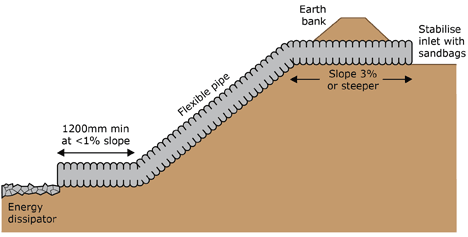
Energy Dissipaters
Used at the outlet of a down drain or lined channel, an energy dissipater will reduce the velocity and associated erosion from the excess flow.
Figure 5: Energy dissipater construction (source: EPA Victoria 2004, Publication 960 p.22)
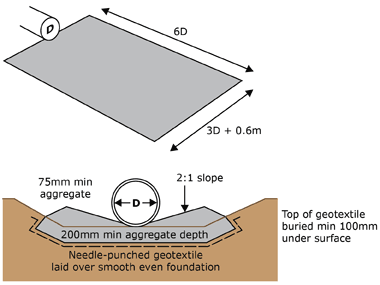
Energy dissipaters should be regularly inspected to ensure:
-
rocks are not being displaced by the flow
-
sediment hasn't built up in the rock to a point where it'll be resuspended during the next storm event (at this point it'll require rock replenishment or replacement)
Stabilisation measures
Some measures used to stabilise exposed earth surfaces include:
-
stabilisation matting
-
revegetation
-
grass establishment
-
rock armouring
Stabilisation matting
Stabilisation matting can be used to cover un-stabilised soils to provide a barrier between the soil and rainfall, run-off and wind. Various types of matting are available including biodegradable, synthetic and biosynthetic combinations.
Selection of material should be based on:
-
how long the measure needs to remain in place – synthetic products often last longer
-
if the matting is required to suppress weeds – thicker products will suppress weeds (thick products are unsuitable if grass establishment through the matting is desired)
-
anticipated flows – synthetic products are often more suited to concentrated flows
-
need for biodegradability – if you want the product to degrade as plants are established, a biodegradable product should be used
Be aware some products can impede water infiltration into the underlying soil. There's also products which lack the density required to suitably provide zero light transmission to the substrate, and therefore adequate weed suppression.
Figure 6: Stabilisation matting installation (source: EPA Victoria 2004, Publication 960 p.8)
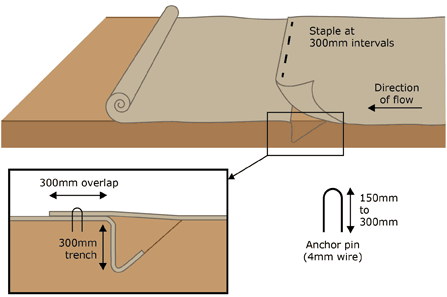
Stabilisation matting should be regularly inspected to ensure:
-
run-off isn't undermining the matting
-
the matting isn't lifting in the wind or has been pulled out of the ground by run-off flows (if installed properly this shouldn't be a problem)
-
biodegradable materials haven't broken down too quickly - where a product is reinforced with plastic netting (not recommended) check the netting hasn't come loose, as this can be detrimental to birds, small reptiles and mammals
-
the matting isn't being buried by sediment – if so the source of the erosion should be targeted and managed
Figure 7: Stabilisation matting (source: Statewide River & Stream Management)
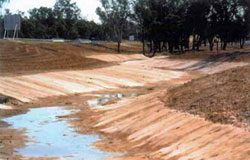
Revegetation
Un-stabilised areas should be progressively replanted with vegetation. Where possible planted vegetation should be part of the final landscape design.
Revegetation prevents erosion by:
-
roots binding soil particles into aggregates
-
providing cover to soil, therefore reducing raindrop impact
-
encouraging the retention of water at the surface
-
reducing wind velocity at the surface
Revegetation will take time to establish before it provides adequate protection against erosion. To assist with establishment of revegetation, and to prevent damage while works are still being conducted, the following should be considered when replanting:
-
staking
-
tree guards
-
stabilisation matting at base
-
‘no-go zone’ establishment
Revegetation with minor damage may have damaged limbs removed. Revegetation which has been significantly damaged should be replaced.
When selecting species for revegetation ensure it's suitable for the area, considering soil type, climatic conditions, etc. Uniformity of planting provides an appealing landscape in high profile locations, e.g. freeways. Some species may require application of water and/or fertilisers during the establishment period.
Grass establishment
Areas disturbed by works may be stabilized by establishing grass. Grass won't be as effective as retaining existing vegetation as it requires time to establish.
Grass may be used both for long-term stabilisation as part of the revegetation of the site or as a protection measure during construction.
Establishment of grass may be through:
-
hand seeding
-
hydro-seeding
-
hydro-mulching
-
laying turf
Where the grass is just being used for protection during construction (e.g. grassing of stockpiles) sterile seed should be used. This method of stabilisation is cost effective and provides both a stabilisation method and time for establishment of strategically planted native plantings.
During the process of grass establishment it may be necessary to reseed patches where the seed hasn't struck or which were missed when seed was initially laid.
Where turf is used, monitoring must be undertaken to ensure run-off flows onto the grass and not along the edge of the turf strip. Where flow is along the edge of the turf strip the flow will be concentrated and erosion exacerbated.
Rock armouring
A layer of rock can provide a barrier between soil and rainfall, run-off and wind to prevent erosion. It can also reduce the velocity and associated erosive tendencies of flow. In some cases the velocity of flow can be slowed enough to encourage sediment to drop out of suspension from run-off.
Rock armour is generally used in areas of concentrated flow. Applications include:
-
drainage channels
-
catch drains
-
outfall drains
-
outlets/inlets for sediment basins
For temporary applications, rock may be placed with or without a geo-textile liner. Where geo-textile isn't used a thicker layer of rock must be used.
Rock used should be an assortment of sizes where possible. The smallest rock size must be able to resist dislodgement in peak flows.
Rock armouring should be regularly inspected to ensure:
-
rocks are not being displaced by the flow
-
sediment hasn't built up in the rock to a point where it'll be resuspended during the next storm event (at this point it'll require rock replenishment or replacement)
Figure 8: Rock armouring construction (source: EPA Victoria 2004, Publication 960 p.24)
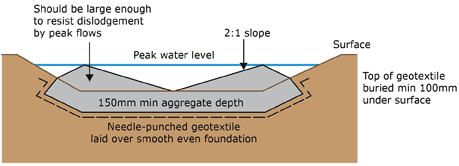
Stockpile management
Ensure stockpiles aren't located next to cross drainage regimes or creeks. It's also advisable not to locate your stock pile beneath the drip line of vegetation as it could cause harm to what you are trying to protect.
Dust prevention
Many of the measures used to prevent erosion will also inhibit dust generation including:
-
spraying water
-
dust suppressants
-
restricting work activities
Spraying water
Water improves soil cohesion, causing particles to stick together and reducing the likelihood of dust generation. Water may be sprayed via:
-
water carts
-
sprinklers
-
hand-held hoses
Areas to be targeted should include:
-
haul roads or other trafficked areas (not at the access point)
-
areas of earthworks
-
stockpiles
Dust suppressants
Dust suppressants are chemical additives which improve the structure of the soil by enhancing the bonds between particles. Dust suppressants, which use water as a carrying agent, are generally the most practical for use on site as they can be added to water sprayed by a water truck for dust suppression.
The use of dust suppressants decreases the frequency in which areas must be sprayed, resulting in savings in:
-
water used on site
-
water cart usage
This can allow larger areas to be targeted for dust suppression.
When selecting a product to use, ensure the product won't have an impact on the environment. Request a copy of the Material Safety Data Sheet (MSDS) to determine any potential effects the suppressant may have on the environment and any practices required to mitigate those effects.
Restricting activities / stop works
In extreme weather conditions (hot, dry and windy) activities resulting in the generation of dust may need to be halted, or all works on site may need to be stopped in response to OH&S issues.
You may also like...
Sediment management measures
Perimeter structures are designed to capture and retain sediment. These structures on the down slope side of an area prone to erosion can inhibit sediment from leaving the area.